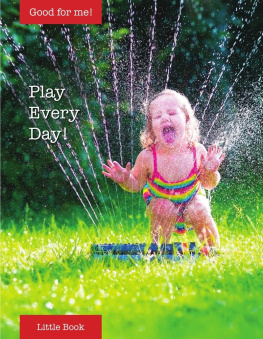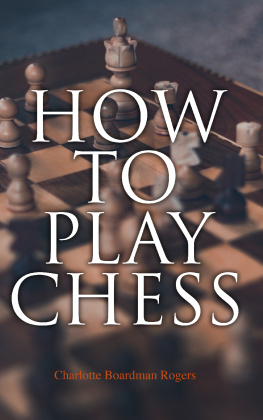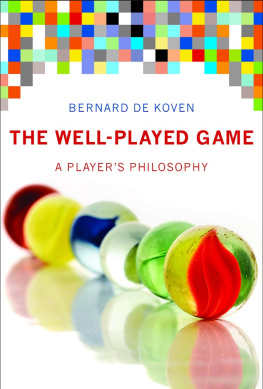I was playing a lot, all my spare time,
and everyone told me to do something useful instead;
They all said I was just wasting my time,
until this team discovered me and offered a contract;
Im now living by playing, doing what I love,
and no one speaks shit about my game anymore.
At the time of writing, in the beginning of 2017, dozens of successful esport players have shared their own versions of the above in interviews, videos, and news reports that promote competitive gaming as the next big thing. And why not, for the stigma of play as idiotic idle is far from dispersed yet. But what about those close to a hundred percent of dedicated players who live in the first half of the narrative, never reaching the epiphanic end? This book is about them.
Across the pages that follow, my aim is to expound the nature and development of esport play as dedicated human action in progress; a compilation of experiences and feelings that millions of esport players are going through over their days, months, and years of engagement with the game. Regardless of the numerous economical, political, and sociological issues that esports are today tangled up with, in this book the phenomenon represents but a modern means to do what those who precede us have been doing for a long while now. I call the frame through which these deep-rooted natural processes will be probed psycholudic development: a course of individual growth that occurs with all kinds of play practices, like esports.
The notion of psycholudic development points subtly at Erik and Joan Eriksons (1982) well-known theory of psychosocial development according to which humans mature throughout various stages, each of which involves respective changes that healthy individuals go through as they live and grow up. In line with the Eriksons premise that playfulness is an essential ingredient in all the stages (76), the lifelong evolution of play and playfulness in humans (and non-humans) can be considered a psychological fact currently in search of its own theories. In response, a key contribution of the present enterprise is a theory of psycholudic development: a structuring of the days, months, and years through which players evolve cognitively, emotionally, and physically along with their respective play activities.
I should make it very clear from the start that almost everything in this monograph draws from my five-year relationship with League of Legends. I will not talk about Counter Strike, Dota, Fortnite, Hearthstone, Overwatch, or StarCraft, even though I have had good times with all of them. The reason for not discussing those titles ties closely to one of the core points made later in this book: people and their play evolve with the things they play, and when it comes to esport play, its embryonic peculiarity is largely determined by the manner in which players attach to a single game for a long time. My idea is thus not to scratch every esport, but to pierce one in order to uncover the depth that they all potentially seal.
Without contesting the fact that there are, no doubt, differences between esport titles, five years is barely enough to access one. Playing lots of different games makes you an expert of game beginnings; and while this book may not reach an ending, it provides an account of the things that lead to one. I do not claim that all esport players remain faithful to one game for years, but many of them do. I do not claim that all my observations are fully applicable to other esports, but many of them are.
The original motivation to write this book is simple and selfish: to fathom why and how I became a League of Legends player to a degree that changed my life for a long time. At the time of (re)writing, my accounts have registered some three thousand hours of active League of Legends play, obviously excluding all related transmedia activities that easily multiply the amount by a number that I do not dare even think of. This makes me a somewhat average player in the ranks of the game, and that is exactly what the study exemplifies: the practices, routines, and sensations that amateurs like me around the world are living with day in day out. As such, me and my study are chronically limited in many ways, which is both a methodological challenge and strength (see especially Taylor 2017; Witkowski 2018).
Regardless of the nontrivial number of existing anthropological methods, the present behavior-driven autography entails one of its own. For want of better terms, be it critical attachment. While a more descriptive label would probably be reflective attachment, I consider reflectiveness essential to all deeper attachmentthe word attachment being given another meaning later. By critical, in turn, I do not intend to invoke critical theory or evaluative (let alone political) criticism, but critical thinking in the most pragmatic sense: an intellectual practice motivated by analyzing, conceptualizing, and synthesizing the experiences that attachment brings alongergo, critical attachment.
From a disciplinary perspective, I see critical attachment as an instrument in the scholarly field that Robert Desjarlais (2012) speaks of as anthropology of passion, an academic sector with particular interest in the ways that people are enraptured by certain endeavors and activities, and of the vectors of such fervor (10). In that context, critical attachment explores the human experience through reflective longitudinal engagement with particular behaviors: not exploring culture in the ethnographical sense, but the phenomenological specificities that endure and evolve in it. Put more precisely: if ethnography aims at an understanding of the cultural context in which the human action takes place (Boellstorff et al. 2012: 16), critical attachment investigates the human action that takes place in the cultural context.
Of Patricia and Peter Adlers (1987) famous membership roles for field research (peripheral members, active members, complete members), critical attachment might be perceived through the latter where scholars immerse themselves fully in the group (67). This, nonetheless, makes a fine case of contrast between ethnography-centered methodologies and critical attachment: there is no group or field to which scholars of critical attachment would enter and immerse themselves (cf. Markham 2013), but rather a system of behaviors and values they undertake. While League of Legends surely has its communities across regions that exist in many forms, from the present methodological perspective it surfaces as a thing more temporal and phenomenological than social and topographical.
To clarify the point still, Leon Andersons (2006) forceful insertion of analytic autoethnography makes a noteworthy reference. Anderson separates his analytic autoethnography, which is committed to a research agenda that contributes to broader social phenomena (375), from phenomenological research based in self-observation that is more suitable for investigations, such as those on processes and stages of skill acquisition (376). In this division, I am more than happy to connect critical attachment to the latter that Anderson associates to anthropologies like that of David Sudnows. Indeed, critical attachment can be situated firmly to the continuum of Sudnows (1978; 1983) phenomenologically shaped anthropology of play, or autophenomenography (Gruppetta 2004), the foci being on the processes and stages of lasting engagement rather than on its sociocultural depth.






